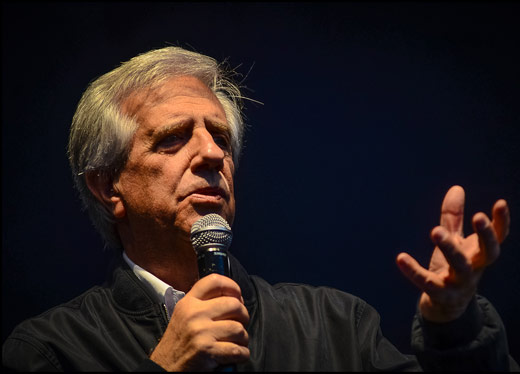
On Sunday, November 30, there were presidential runoff elections in Uruguay. To nobody’s surprise, the election was won handily by former President Tabaré Vazquez of the Broad Front (Frente Amplio). The margin was large: 56.63 percent for Vazquez, and 43.37 percent for the candidate of the right wing National Party, Luis Alberto Lacalle Pou. The Broad Front retains a slim majority in both houses of Congress.
Tabaré Vazquez, a physician who was president of Uruguay from 2005 to 2010, replaces incumbent President José Mojica, also of the Broad Front. Uruguayan law does not allow immediate reelection of sitting presidents.
In the first round of the elections, held October 26, Vazquez and his vice presidential running mate, Raul Sendic, got 49.45 percent of the vote, almost avoiding a runoff. Lacalle Pou got 31.94 percent in the first round, while Pedro Bordaberry, son of former dictator Juan Maria Bordaberry, got 13.33 percent and the rest of the votes were spread among two other candidates.
The Broad Front is an electoral and legislative alliance of some 12 political parties, including the Uruguayan Communist Party, the Uruguayan Socialist Party, the Liber Seregni Movement, the Popular Participation Movement and others on the left.
Foreign media commentary has concentrated on outgoing President Mujica’s self-effacing personal style and his government’s experiments in legalizing marijuana use, abortion and same-sex marriage. Also sometimes mentioned is Mujica’s offer to President Obama to take some of the prisoners at the Guantanamo Bay Naval Base off his hands. Seldom mentioned is the fact that this offer was accompanied by a plea by Mujica for the freedom of the “Cuban Five”.
However, the Vazquez victory should be seen also as falling within the context of the Bolivarian dynamic, a multinational movement in South America, Central America and the Caribbean, which seeks to reduce nations’ dependence on, and submission to, the United States, while at the same time increasing horizontal economic integration and sociopolitical solidarity for the countries south of the Rio Grande. Though there are those on the left who disparage this phenomenon as fools’ gold, a diversion from true revolutionary struggle, most communist and Marxist groups in the region see it as the best thing that has happened within the socialist movement in many years.
Although Uruguay is very small and is not part of the most radical component of the Bolivarian movement, the Bolivarian Alliance for the Peoples of our America, which was initiated by Cuba and Venezuela and now includes also Bolivia, Ecuador, Nicaragua and a number of small Caribbean island states, it has, under Vazquez and Mujica, played a supportive role, alongside such countries as Chile, Argentina and Brazil.
Starting with the election of Michelle Bachelet as president of Chile (for the second time) a year ago, no sitting left wing government in Latin America has been defeated for reelection in a twelvemonth. The left has won presidential elections in El Salvador, Bolivia, Brazil and now Uruguay, while centrists have been elected in Panama and Costa Rica. An effort by the ultra-right headed by former President Alvaro Uribe to oust President Santos of Colombia was thwarted by voters, allowing peace talks with the FARC guerrillas, which Uribe said he would scuttle, to continue. .
There are many problems for the left region wide, but it would seem that the “pink tide” in Latin American politics continues to predominate. Whether our own U.S. government is yet willing to accept this is another matter.
Photo: Tabaré Vazquez, Carlos Lebrato, Frente Amplio Uruguay










